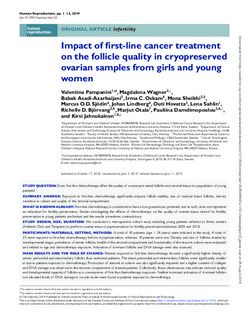| dc.description.abstract | STUDY QUESTION : Does first-line chemotherapy affect the quality of ovarian pre-antral follicles and stromal tissue in a population of young patients?
SUMMARY ANSWER : Exposure to first-line chemotherapy significantly impacts follicle viability, size of residual intact follicles, steroid secretion in culture and quality of the stromal compartment.
WHAT IS KNOWN ALREADY : First-line chemotherapy is considered to have a low gonadotoxic potential, and as such, does not represent an indication for fertility preservation. Studies investigating the effects of chemotherapy on the quality of ovarian tissue stored for fertility preservation in young patients are limited and the results sometimes contradictory.
STUDY DESIGN, SIZE, DURATION : We conducted a retrospective cohort study including young patients referred to three centers (Helsinki, Oslo and Tampere) to perform ovarian tissue cryopreservation for fertility preservation between 2003 and 2018.
PARTICIPANTS/MATERIALS, SETTING, METHODS : A total of 43 patients (age 1–24 years) were included in the study. A total of 25 were exposed to first-line chemotherapy before cryopreservation, whereas 18 patients were not. Density and size of follicles divided by developmental stages, prevalence of atretic follicles, health of the stromal compartment and functionality of the tissue in culture were evaluated and related to age and chemotherapy exposure. Activation of dormant follicles and DNA damage were also assessed.
MAIN RESULTS AND THE ROLE OF CHANCE : Patients exposed to first-line chemotherapy showed a significantly higher density of atretic primordial and intermediary follicles than untreated patients. The intact primordial and intermediary follicles were significantly smaller in size in patients exposed to chemotherapy. Production of steroids in culture was also significantly impaired and a higher content of collagen and DNA damage was observed in the stromal compartment of treated patients. Collectively, these observations may indicate reduced quality and developmental capacity of follicles as a consequence of first-line chemotherapy exposure. Neither increased activation of dormant follicles nor elevated levels of DNA damage in oocyte nuclei were found in patients exposed to chemotherapy.
LIMITATIONS, REASONS FOR CAUTION : The two groups were not homogeneous in terms of age and the patients were exposed to different treatments, which did not allow us to distinguish the effect of specific agents. The limited material availability did not allow us to perform all the analyses on the entire set of patients.
WIDER IMPLICATION OF THE FINDINGS : This study provides for the first time a comprehensive analysis of the effects of first-line chemotherapy on the health, density and functionality of follicles categorized according to the developmental stage in patients under 24 years of age. When exposed to these treatments, patients were considered at low/medium risk of infertility. Our data suggest a profound impact of these relatively safe therapies on ovarian health and encourages further exploration of this effect in follow-up studies in order to optimize fertility preservation for young cancer patients.
STUDY FUNDING/COMPETING INTEREST(S) : This study was funded by the Swedish Childhood Cancer Foundation, the Finnish Cancer Society, the Finnish Pediatric Research Foundation, the Väre Foundation for Pediatric Cancer Research, The Swedish Research Council, the Stockholm County Council (ALF project) and Karolinska Institutet. The authors have no conflict of interest to declare. | nb_NO |
